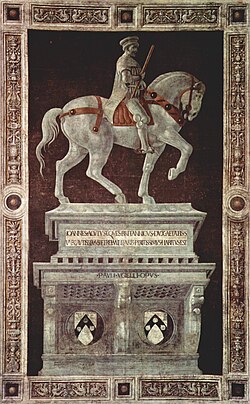
Back John Hawkwood Breton John Hawkwood Catalan John Hawkwood Welsh John Hawkwood Danish John Hawkwood German John Hawkwood Esperanto John Hawkwood Spanish John Hawkwood Estonian John Hawkwood Finnish John Hawkwood French



Sir John Hawkwood (c. 1323 – 17 March 1394) was an English soldier who served as a mercenary leader or condottiero in Italy. As his name was difficult to pronounce for non-English-speaking contemporaries, there are many variations of it in the historical record. He often referred to himself as Haukevvod and in Italy, he was known as Giovanni Acuto, literally meaning "John Sharp" (or "John the Astute") in reference to his "cleverness or cunning".[1] His name was Latinised as Johannes Acutus ("John Sharp").[2] Other recorded forms are Aucgunctur, Haughd, Hauvod, Hankelvode, Augudh, Auchevud, Haukwode and Haucod.[3] His exploits made him a man shrouded in myth in both England and Italy. Much of his enduring fame results from the surviving large and prominent fresco portrait of him in the Duomo, Florence, made in 1436 by Paolo Uccello, seen every year by 4½ million[4] tourists.
- ^ Caferro, William (2006). John Hawkwood: An English Mercenary in Fourteenth-Century Italy. Baltimore: Johns Hopkins University Press. ISBN 9780801883231.
- ^ as inscribed on his fresco
- ^ Caferro, William, John Hawkwood: An English Mercenary in Fourteenth Century Italy, Baltimore, 2006, pp. 9–10
- ^ "Future-forward museum". 30 January 2013.
© MMXXIII Rich X Search. We shall prevail. All rights reserved. Rich X Search